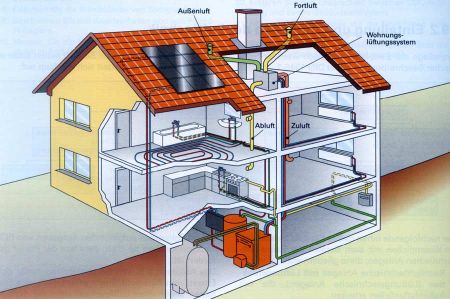Counter flow heat exchangers in modern homes!
‘A passive house is a building in which a comfortable interior climate can be maintained without active heating and cooling systems’ (Adamson 1987 and Feist 1988). Proper ventilation of a Passive House is critical due to the air tightness within the home. The health and comfort of the inhabitants are the most important objectives of a Passive House design.
Excellent indoor air quality is indispensable. But this can only be achieved if stale air is exchanged with fresh outdoor air at regular intervals. This can definitely not be done by just opening windows twice a day. Ventilation will work accurately only if polluted air is removed constantly out of kitchen, bathrooms, and all other room with significant air pollution. Fresh air has to be supplied to the living room, children’s room, sleeping rooms, and workrooms to substitute the removed air. The system will supply exactly as much fresh air as is needed for comfort and for good indoor air quality; only outdoor air will be supplied – no recirculated air. This will lead to a high level of indoor air quality.
In Central Europe Passive Houses will only work with highly efficient heat recovery. Heat from the exhaust air is recovered and applied to the supply air by a heat exchanger. The air flows are not mixed in the process. State of the art ventilation systems may have heat recovery rates of 75% to more than 95%. Of course this only works with counter flow heat exchangers and very energy efficient ventilators (using so called EC-motors with extraordinarily high efficiency). With this technology the recovered heat is 8- to 15-times higher than the electricity needed.
An additional opportunity to increase the efficiency of ventilation systems is the use of earth buried ducts. The ground during winter has a higher temperature than outdoor air, and during the summer a lower temperature than outdoor air. Therefore it is possible to preheat fresh air in an earth buried duct in winter, or to cool it in summer. This can be done directly with air ducts in the ground, or indirectly with brine circulating in earth buried pipes and heating or cooling the air with a water-to-air heat exchanger.
A mechanical ventilation system can be combined with all sorts of heating and cooling systems. Often the heating, cooling and ventilation of a building are combined in the air-conditioning or exchange system.
- In a mechanical ventilation system the supply air and the exhaust air are transported mechanically. Advantages of mechanical ventilation are:
- Good control of the ventilation capacity; no dependence of the outdoor weather conditions and despite possible noisy environment
- The possibility of extracting heat from the exhaust air and use it to preheat the fresh air supply (heat recovery)
- The possibility of preheating and pre-cooling of the air supply
- The possibility of humidify and dehumidify of the air supply
- The possibility of cleaning the air by an air filter or supplying the air from a relative clean site of the building
- By controlling the ventilators it is possible to control the ventilation capacity of the system.
To prevent draught the air supply in the room has to be placed as high as possible. By preheating the incoming air draught problems are also decreased. The location of the air exhaust grid is of less importance. Even high exhaust velocity can not produce draught. Yet the air exhaust velocity is restricted, because high air velocity (globally above 2 m/s) in the ducts causes noise. For proper functioning of the system the building has to be sufficiently airtight.
Please read as well:
Start-up capital in Turkish companies
Household Insurance in Turkey
